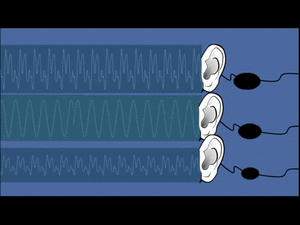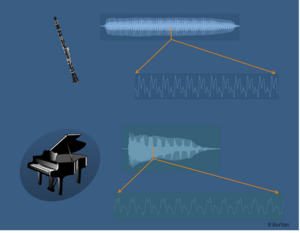Sound facts for kids


Sound is what we hear when sound waves travel through something and reach our ear. All sounds are made by tiny movements called vibrations. These vibrations happen in the molecules of the material the sound is moving through.
For example, when you hit a drum or a cymbal, the object shakes or vibrates. These vibrations make the air molecules around them move. Sound waves then travel away from the drum, moving through these air molecules. When these vibrating air molecules reach our ears, our eardrum also starts to vibrate. The tiny bones inside our ear vibrate in the same way.
These vibrations allow us to hear many different sounds. Even music is made of these organized vibrations. Sounds that have irregular or messy vibrations are often called noise.
Sound waves are a type of longitudinal wave. This means they move by pushing and pulling the material they travel through. They have two main parts: compression and rarefaction. Compression is where the air molecules are squeezed close together. Rarefaction is where the molecules are spread far apart. A sound wave is a series of these compressions and rarefactions moving along.
Contents
How Sound Works
Sound can travel through different materials like air, water, and solid objects. It moves as longitudinal waves. In solids, sound can also travel as a transverse wave. Sound waves start from a source, like the vibrating part of a speaker. This source creates vibrations in the material around it.
As the source keeps vibrating, these movements spread out from the source. They travel at the speed of sound, forming a sound wave. As sound waves travel, they can be reflected (bounce off things), refracted (bend as they pass through different materials), or attenuated (get weaker).
The way sound travels is usually affected by three things:
- How dense and pressurized the material is. This relationship, which changes with temperature, affects how fast sound moves through the material.
- If the material itself is moving. For instance, if sound travels with the wind, it will move faster. If it travels against the wind, it will slow down.
- How thick or sticky the material is (its viscosity). This affects how quickly the sound gets weaker. For many common materials like air or water, this weakening is very small.
If sound moves through a material that isn't the same everywhere, it might bend or spread out.
The vibrations that we hear as sound can travel through all forms of matter: gases, liquids, and solids. The material that carries the sound is called the medium. Sound cannot travel through a vacuum, which is empty space. This is why astronauts cannot hear each other directly in space. They need a radio to communicate.
How Fast Does Sound Travel?
Sound travels faster through water than through air. It travels even faster through solid materials like stone, iron, and steel.
In air that is 20 °C (68 °F) warm at sea level, sound travels about 343 m/s (1,230 km/h; 767 mph). You can estimate this speed using a simple formula: v [m/s] = 331 + 0.6 T [°C].
In fresh water, sound moves much faster, about 1,482 m/s (5,335 km/h; 3,315 mph). In steel, sound is incredibly fast, traveling at about 5,960 m/s (21,460 km/h; 13,330 mph).
Pitch and Loudness
Pitch is how high or low a sound seems to us. Pitch is determined by the sound's frequency, which is the number of vibrations per second. For example, the highest key on a piano vibrates 4,000 times per second. This means it has a frequency of 4000 hertz (Hz), or 4 kilohertz (kHz). Lower keys on the piano have lower frequencies. A note that is an octave higher than another note has twice its frequency.
The intensity of a sound tells us how much sound energy passes through a certain area in one second. Sound waves with a bigger vibration (higher amplitude) have higher intensity. Sound is more intense when you are closer to its source. As you move farther away, it becomes less intense. When you double your distance from a sound, its intensity becomes one-quarter of what it was.
Sound intensities can vary a lot. They can range from sounds barely heard (0.000000000001 W/m2) to painfully loud ones (1 W/m2). The decibel scale makes these numbers easier to understand. A sound intensity of 0.000000000001 W/m2 is called 0 dB (decibels). When the decibel number goes up by 10, the sound intensity is ten times greater. So, a 1 W/m2 intensity is 120 dB.
Loudness is how people feel or perceive the intensity of a sound. Loudness depends on the sound's intensity, its frequency, and how well a person can hear.
Sounds We Can and Cannot Hear
Sounds that human beings can hear have frequencies between 20 Hz and 20,000 Hz (or 20 kHz). Sound waves with frequencies above 20 kHz are called ultrasound waves. Sound waves with frequencies below 20 Hz are called infrasound waves. Humans cannot hear ultrasound or infrasound waves. However, some animals, like bats and dolphins, use them to navigate or communicate. As people get older, their hearing range often becomes smaller. Most people hear best with sounds between 1000 Hz and 6000 Hz.
The Doppler Effect
When a sound source, like a siren, moves towards you, its frequency seems to increase. This makes the sound appear higher in pitch. The same thing happens if you move towards the sound source. When a sound source moves away from you, or you move away from it, the frequency seems to decrease. This makes the sound appear lower in pitch. This change in perceived frequency due to motion is called the Doppler effect.
Images for kids
See also
 In Spanish: Sonido para niños
In Spanish: Sonido para niños







